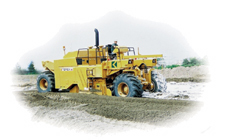by Diana Barnum
Correspondent
Making a profit through asphalt
recycling while at the same time extending pavement life and stabilizing
soil beds is the bread-and-butter of Kelchner Excavating’s growing
business.

The Dayton, Ohio-based company utilizes a proven method of extending
pavement life while reducing maintenance costs through soil
stabilization.
In a nutshell, stabilization is the mixing of lime or
cement with subgrade soils so that a chemical reaction results in a more
durable, stable subgrade.
“We also do full-depth, in-place recycling
of asphalt. The beauty of it is that we use mobile equipment,” said Todd
Kelchner, owner of Kelchner Excavating.
His company specializes in
excavation, utilities, stabilization and landfill construction. With
approximately 90-100 employees, the goal is $17.5 million in annual sales,
a figure they are right on target to hit. And asphalt recycling and
stabilization is generally targeted at 8% to 10% of the company sales,
notes Kelchner.
When asphalt surfacing shows that “alligatoring” effect
with cracks in the surface or potholes, a couple of options are available.
A new layer of asphalt can be applied inexpensively. However, just as
repainting over chipped paint would eventually reshow the chips and at
best is only a temporary fix, the same holds true for asphalt recovering.
A different alternative is to take out the asphalt and gravel base and
replace it with all new material, correcting the main problem: a weak
subgrade.
Kelchner’s steps in soil stabilization:
1. Go in and grind
up to about 18-inches deep. Pulverize asphalt and mix gravel and dirt
base.
2. Introduce precise measurements of lime dust or cement material
over the top, add water and mix. The result is firm subgrade, like
concrete, in 24 hours or less.
3. After drying, add new surface of
traditional asphalt, about 2-inches thick.
Equipment for the soil
stabilization process includes a standard paver and a CMI RS650 grinder.
Kelchner also uses a homemade truck for lime dust, created out of an
articulated haul truck. In place of the removed truck bed, he placed a
tank outfitted with an agricultural application for computerized controls
to effectively handle dust emissions and to measure lime by dialing in
precise rate per square yard.
In a white paper called, “Benefits of
Soil Stabilization in Site Preparation for Parking Lots, Roadways and
Building Pads”, Kelchner Excavating points out the primary economic and
structural benefits as:
• Reduction of surface maintenance costs by at
least 50%.
• Extension of pavement life by as much as twice that of
non-stabilized surfaces or 100%.
• Improvement in materials’
resistance to moisture, thawing and freezing conditions. And resistance to
expansion, swelling, cracking and buckling like unstabilized clay.
•
Reduction in pavement thickness requirements - resulting in lower
costs.
• Improvement of construction site conditions and scheduling
with decreased downtime even in bad weather.
Savings? Let’s look at
some projects and see.
Projects
On a project in Dayton, Ohio,
Kelchner Excavating contracted to develop a 225,000-square-foot shopping
center. They used the CMI RS 650 to grind 70,000 square yards of asphalt
parking lot and crushed concrete for base under the Wal-Mart. Then they
pulverized the asphalt and mixed it in with gravel materials from
underneath to create gravel backfill and a gravel road-base for their
parking lot. The grinder operated at a rate of about 10,000 square yards
per 10-hour shift.
“We probably saved them $100,000,” said
Kelchner.
At a site in Beavercreek, Ohio, Oberer Development was
working on 6,000 square yards at the 30-lot Kables Mill Subdivision in
Green County. When the site contractor began street work, he could not
pass a proof-roll inspection, even after trying for a couple of weeks.
Kelchner was called. In less than three days, they had the project
stabilized and passing the proof inspection even with heavy rains
ongoing.
At another site, a distribution center in Cleveland, Ohio,
Kelchner worked with a general contractor on a 100,000-square-foot
warehouse and parking lot. These results were reported:
“... a longer
lasting parking lot, that will have less than half the normal maintenance
cost over time, and the owner paid nothing extra for the stabilization. By
properly assessing the increased strength gain by stabilizing the
sub-grade, the originally designed base and asphalt thickness was reduced,
saving enough money to pay for the total cost of the stabilization.”
On
another project, a retail Store in Saginaw, Michigan, Kelchner was a
sub-contractor for a 150,000-square-foot building. The soils were wet and
soft, slowing down work. An estimated entire summer — or three months —
would have been needed to conventionally dry out the area using disking
and aerating. However, Kelchner’s soil stabilization with lime speeded up
the process in one week.
For more information about soil
stabilization, contact Kelchner Excavating at 6834 Loop Road, Centerville,
OH 45459. Call toll free: (800) 229-1334, or fax inquiries to: (937)
434-3807. |